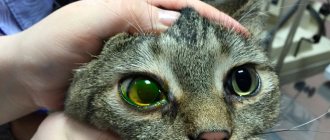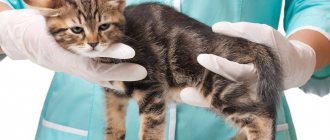What is toxoplasmosis
The disease is classified as infectious. It is caused by microscopic protozoan parasites called Toxoplasma. Unlike other carriers of toxoplasmosis, cats are the primary host, not an intermediate host. Because of this, the full development cycle of parasites is possible only in the body of representatives of the cat family.
Pathogen
The pathogen is resistant to external factors and is widespread throughout the world. Its carriers are all warm-blooded animals, including several dozen birds and humans. To destroy Toxoplasma, electromagnetic radiation, drying, heating to 55°C and some disinfectants (phenol, chloramine, alcohol solutions) are used.
Depending on the host, protozoa reproduce by fission in infected cells or sexually in the host's intestines. In the second case, they enter the environment along with feces. This type of reproduction is used exclusively in the body of the main host, so the cat family contributes more than others to the spread of infection.
How the disease develops
The pathogen is characterized by gradual development. In intermediate hosts they go through 2 stages:
- Bradyzoites
. They are formed in the cells of internal organs captured by the parasite. They prefer nerve and muscle tissues. They reproduce by division. Invisible to the immune system, as they hide inside healthy cells. While maintaining their integrity, the cells remain unchanged until the end of the host's life.
- Tachyzoites
. Formed when an infected cell ruptures. They form new parasites, but are easily eliminated by the immune system.
The last stage of the life cycle is found only in cats. When infected, oocysts appear in their small intestine. Sick pets infect others through their feces for 3 weeks. Inside the body, parasites quickly spread through the bloodstream, releasing toxins and causing necrotic processes in internal organs.
How can you become infected with toxoplasmosis and when is it dangerous?
Of course, communicating with a cat who is in an acute form of the disease potentially carries risks for the owners. But if you follow basic hygiene rules, you can help your pet without harming your health and the health of other people living in the house.
Fact No. 1.
Oocysts excreted in cat feces are non-invasive for the first 5 days from the moment they enter the external environment. This means that for a real danger to arise, it is necessary not to escape in the litter box for at least several days, or to do it with bare hands without observing personal hygiene.
Fact No. 2.
The release of oocysts occurs only during the first 14 days from the moment of infection and does not recur, since immunity arises in the body of a healthy cat, which suppresses the activity of T. Gondii.
Fact No. 3.
A cat that has had toxoplasmosis does not pose a danger to others.
Fact No. 4.
Toxoplasmosis is not transmitted from person to person (with the exception of transmission from mother to fetus during pregnancy).
Fact No. 5.
For most healthy people, the fact of contact with Toxoplasma does not mean the development of the disease. A strong immune system quickly neutralizes the parasite, but a serological test will show the presence of antibodies throughout life. Serious problems, as a rule, arise in people with very low immunity (after serious illnesses) and those with AIDS (not carriers, but those suffering from this disease).
Thus, it is easy to understand that the likelihood of becoming infected with a parasite from a poorly cooked kebab or rare steak is much higher among lovers of this type of food than from a domestic cat.
The main danger of toxoplasma is associated with the initial penetration of the parasite into a woman’s body during pregnancy. If the mother's immune system is not yet familiar with T. Gondii and is not ready to give a quick response, the fetus becomes infected with such serious consequences as:
- intrauterine fetal death;
- development of serious defects (including nervous system disorders);
- the birth of a child with signs of the acute phase of the disease (fever, acute poisoning of the body, liver failure).
The degree of damage to the fetus and the prognosis depend on the stage of pregnancy at which the infection occurred.
How cats become infected with toxoplasmosis
Outside a living organism, oocysts live up to 1.5 years, so they can almost always be found in soil or water. They can be infected in 4 ways:
- Contact
. The disease is transmitted from cats infected with toxoplasmosis. Their feces pose a particular danger, but transmission through saliva by contact with damaged skin or mucous membranes is also possible.
- Transplacental
. An infected mother can infect her kittens through the placenta. In this case, the disease occurs in an acute form.
- Nutritional
. Whiskered pets often become infected with protozoa by eating sick birds and mice. Feeding raw meat and fish infected with toxoplasma is no less dangerous.
- Airborne
. Occurs only in the pulmonary form of the pathology.
The duration of the incubation period directly depends on the method of infection. When eating contaminated foods, it takes 18 days for symptoms to appear, but when sniffing cat feces, it takes only 3 days.
How does toxoplasmosis spread from a cat?
When Toxoplasma begins to multiply in a cat's body, the cat becomes a potential carrier of the infection.
As already written above, Toxoplasma reproduces sexually and asexually. When the infection settles in the intestinal epithelium of an animal, the cysts are released along with the feces. It is easy for a person to become infected by cleaning a cat's litter box.
Stray cats love to defecate in sand, and children's sandboxes are often their favorite places to defecate. Children playing in sand containing feces infected with toxoplasmosis also run the risk of contracting the infection.
If helminthiasis develops in an asexual form in a cat’s body, then any secretions become dangerous: saliva, nasal discharge, urine, even milk (in a nursing cat).
Infection with toxoplasmosis can occur during normal caresses with your pet, especially through kissing. This is why doctors and veterinarians prohibit kissing their pets.
But in rare cases, the owner and the cat can become infected at the same time if they eat a dish contaminated with toxoplasma. Pathogenic microorganisms often live in fish and meat products. Poorly cooked meat or a dish deliberately cooked with blood becomes a source of infection. It is enough to eat such food yourself and treat your cat to it, and the whole family will be infected.
© shutterstock
Causes of infection and risk groups
The main causes of infection include the consumption of foods that have not undergone heat treatment and free walking on the street. Despite this, a stay-at-home pet can also get sick. In his case, the parasites enter the house on the owner’s clothes and shoes.
Cats are most rarely infected by transfusion of infected blood. This is due to the negligence of doctors who are obliged to carefully check the health of each donor.
In addition to homeless animals and animals that often walk outside, the risk group includes pets with low immunity.
These include:
- elderly (over 6-7 years old) and young (up to 1 year old) individuals;
- cats weakened by chronic diseases, recent surgery or viral infection;
- shelter residents kept in crowded conditions.
The cause of infection in newborn kittens may be the milk of a mother who fell ill shortly after birth. By remembering how to identify toxoplasmosis in cats, you can avoid further spread of the disease - becoming familiar with the symptoms will help with this.
Routes of infection
Most often, Toxoplasma enters a cat's body through the mouth, for example, by eating a sick mouse or licking a paw soiled in soil. Stray cats, as well as animals that have free access to the street, can become infected with toxoplasmosis through contact with small birds. Rodents and birds can be intermediate hosts of Toxoplasma. In such cases, infection can occur not only through nutrition (by eating food), but also simply through contact with a carrier. Sometimes the parasite enters the animal's body through water or contaminated food, such as unprocessed meat. That is why it is recommended to freeze raw meat before serving it to your cat. The microscopic parasite dies at a temperature of -25 degrees.
Veterinarians note that young cats under 1 year of age and older animals over 7 years of age are at greater risk of developing toxoplasmosis than pets aged 1 to 6 years. This is due to the cat's immunity. Before a year, a cat is still considered a kitten, and after 7 years it is already an elderly pet, so at this age the animal is simply more vulnerable. Therefore, another risk group consists of weak, sick or malnourished cats.
Even a clean, well-groomed cat can get toxoplasmosis if it eats raw, unprocessed meat.
When Toxoplasma enters a cat's body, it invades tissue cells and is divided into 2 groups. The first group begins active reproduction in the small intestine. This is how oocysts are formed (this is a temporary form of existence of the parasite), which are then excreted in feces. This is why it is so important to wash your cat's litter box thoroughly and frequently. In the pot, the oocysts mature (more than a day) and become dangerous to humans. The release of cysts continues for 3 weeks from the moment of infection. The second group of Toxoplasma immediately invades tissue cells and spreads throughout the animal’s body, destroying tissue. This leads to various disturbances in the functioning of internal organs and the appearance of symptoms.
Is the disease dangerous for humans?
A person can become infected from a cat even when the animal has no symptoms of toxoplasmosis. The parasite enters the human body through contact with a cat or litter box. While licking, the animal can leave traces of toxoplasma on the fur, so you should not kiss the cat. Those who pet the pet need to wash their hands, etc. A healthy adult may not be afraid of infection, since in this case the parasite does not pose a danger (Toxoplasma is locked inside the cells). The danger comes from protozoa that enter the embryo's body (infection occurs through the placenta). Therefore, pregnant women need to be careful when interacting with pets. The child may be born with a pathology, in addition, a frozen pregnancy or miscarriage may occur. Therefore, pregnant women are not recommended to clean cat litter boxes.
This is a disease of dirty hands. I'm guessing you were just washing your hands after petting the cat.
slb.michael, forum user
https://www.komarovskiy.net/forum/viewtopic.php?t=18776
Toxoplasmosis is dangerous for pregnant women
Unknowing people, having heard at least once about the danger of toxoplasmosis, advise pregnant women to get rid of the cat, since the baby will be born with “deformities.” This is also not entirely correct. The fact is that a person can have immunity if he has already had toxoplasmosis. It is possible to find out whether a person was once infected, but for this you need to get tested. If it turns out that the woman has immunity, then there is no need to be afraid of the sore, even if the cat has obvious signs of the disease.
And in cases where a woman has never been infected with these protozoa, then she needs to be careful. Moreover, it is recommended not only to limit contact with the cat, because infection can occur when cutting meat, and when eating unwashed vegetables and fruits, and even when working in the garden. The risk group includes people who eat low-cooked meat, stroganina, etc. In addition, the infection can enter the human body through organ transplantation or blood transfusion. There is also a transmissible method of infection - through the bite of a blood-sucking insect.
Infection can also occur when caring for an infected animal. A sick cat may sneeze or cough, and the parasite's oocysts in the saliva can land on human mucous membranes. The owner can also become infected if he has wounds or damaged skin.
A cat's owner can become infected with toxoplasmosis without the cat's participation.
A person infected with toxoplasmosis may be so ill that there are no symptoms - this is a latent form of the disease. Such cases occur in people with strong immunity. Such people may also have a chronic form of the disease. With this form there are practically no symptoms, but sometimes exacerbations occur. At the same time, the temperature rises slightly, weakness, irritability and nervousness appear. Memory or sleep may deteriorate, and there may be severe headaches. Lymph nodes enlarge, joints hurt and ache, appetite disappears. Sometimes abdominal pain or disturbances in sexual function are noted. Less commonly, a symptom such as blurred vision appears. In general, we can say that the symptoms of toxoplasmosis resemble those of the flu.
The acute form of the disease is much more dangerous. There may be hyperthermia, swollen lymph nodes and joint pain. In addition, there may be conjunctivitis, signs of pneumonia or encephalitis. Clinical signs can be almost anything; this is due to the fact that Toxoplasma can affect all human organs at once. Treatment of all forms of toxoplasmosis, except latent, depends on the duration of infection. Antiprotozoal drugs are usually prescribed, which need to be taken for a long time. However, to do this you need to do an enzyme immunoassay, which can detect antibodies.
Symptoms at different stages
The first symptoms and signs of toxoplasmosis in cats resemble a common cold. This prevents owners from recognizing a dangerous disease at an early stage. Veterinarians recommend contacting a veterinary clinic if you find:
- vomiting and problems with stool;
- elevated temperature;
- apathy and loss of activity;
- rhinitis, lacrimation and cough;
- poor appetite;
- twitching of the tips of the ears;
- enlarged lymph nodes.
Depending on the state of the immune system, the disease occurs in 3 forms: asymptomatic, subacute and acute. If the immune system is strong, then antibodies destroy toxoplasma in 3 weeks. Due to the impossibility of reproduction, the disease becomes chronic, and the animal ceases to pose a danger to others.
How toxoplasmosis manifests itself in cats depends on the stage of the pathology. At later stages, the symptoms are supplemented by:
- purulent discharge from the eyes and nose;
- itching and hair loss;
- yellowing of mucous membranes and inflammation of the eyes;
- difficulty breathing;
- complete loss of appetite;
- muscle cramps, loss of coordination, or paralysis.
An advanced infection is fraught with pneumonia, nephritis, enterocolitis, hepatitis and encephalitis. If complications occur, the probability of recovery is only 10%. If you notice any of the warning signs, it is important to have your cat tested for toxoplasmosis as soon as possible.
Development cycle of Toxoplasmosis
The life cycle of Toxoplasma gundi occurs during two stages of reproduction:
- Sexual - it is characteristic only of feline species and occurs in the tissues of their intestines in any form.
- Asexual - can occur in any warm-blooded organism.
Microbiologists have so far distinguished no more than three forms of Toxoplasma that can be transmitted and infect:
- Sporulated oocysts. A sick individual excretes unsporulated and non-infectious cysts with feces. In the period of 1-5 days they sporulate, and at the same time become dangerous to others. This process depends on temperature and humidity. Oocysts can be quickly eliminated immediately after release, but if sporulation occurs, they survive in almost any environment (especially liquid) at a temperature of +4...+55 °C for several years.
- Bradyositis - they are concentrated in all internal organs of the cat (in cysts), especially in the intestines.
- Tachyosites - divide very quickly in any cells of both the carrier and the carrier (except the intestines).
Diagnostics and tests
To have your pet checked, you do not need to be sick. In case of imminent mating or pregnancy, a preventive examination is recommended.
Diagnosis of toxoplasmosis in cats involves the following studies:
- Study of smears from the mucous membranes of the mouth and nose, as well as washings and effusion fluid. In an infected animal, active division of parasites is observed.
- Stool analysis. Effective only in the initial stages. If your pet shows symptoms of the disease, then all the oocysts have already died.
- Blood analysis. The diagnosis is confirmed by detecting an increased number of protective cells: lymphocytes, eosinophils, neutrophils. A biochemical blood test for toxoplasmosis in cats reveals an increase in bilirubin and enzymes responsible for the synthesis of amino acids (ALT, AST).
- Ultrasound and X-ray. Pathological changes in the lungs and liver are detected.
- Bioassay. A sample of cat blood is tested on laboratory mice to study their response.
The most informative study is ELISA, that is, enzyme-linked immunosorbent test (ELISA). With its help, the appearance of immunoglobulins M and G is detected - antibodies produced by the body to fight toxoplasma. The highest values of these indicators are typical for animals with weak immunity or in constant contact with a source of infection.
Depending on the ratio of the number of antibodies, the duration of infection is determined. If the ELISA results show the presence of immunoglobulin A, then the form of the disease is recognized as chronic.
Diagnosis and treatment
To confirm the diagnosis of toxoplasmosis or establish the fact that the animal has already been ill before, laboratory tests will be required.
Important! Stool analysis in this case is not informative, since the period of oocyst formation is less than 3 weeks and during this period the disease most often goes undetected.
Veterinarians recommend the following types of diagnostics:
- serological blood test;
- polymer chain reaction method;
- diagnostics of material taken from a cat on a laboratory mouse.
Treatment of toxoplasmosis is a complex and lengthy process. It can last for months, years or even until the end of the animal's life. Often the parasite cannot be completely destroyed, since the protozoa, neutralized by the immune system, are in isolated capsules through which medications do not penetrate. T. gondii can remain in this state for an incredibly long time.
In most cases, treatment comes down to suppressing the inflammatory process caused by the activity of protozoa, suppressing the development of cysts and eliminating symptoms. To do this, the veterinarian may prescribe:
- antibiotics;
- anti-inflammatory drugs;
- drugs that enhance immunity.
If a cat diagnosed with toxoplasmosis lives in the house, the following precautions should be taken:
- Clean the tray daily.
- Treat the tray with a 10% ammonia solution.
- Perform these procedures wearing disposable gloves.
- Wet cleaning of the house using disinfectants.
- Regular hand washing after each contact with your pet.
Treatment regimen and prognosis
Treatment of toxoplasmosis in cats comes down to eliminating symptoms and chronicity of the pathology. All mustachioed patients who have completed the full course of therapy are recommended to undergo ELISA annually. Timely monitoring of the amount of antibodies eliminates the occurrence of exacerbation during relapses.
The stronger the immune system, the shorter the duration of treatment and the likelihood of complications. On average, it takes only 2 days to suppress symptoms. The main medications prescribed by veterinarians include:
- immunostimulants (vitamin B, folic acid, glucose);
- Chemical coccide recommended for acute pathology;
- mineral and vitamin complexes;
- antibiotics (Clindamycin, Rovamycin, Biseptol) that prevent the division of parasites;
- glucocorticosteroids (Prednisolone, Dexamethasone), necessary to relieve eye inflammation;
- Spiramycin, used during pregnancy;
- anti-inflammatory drugs and diuretics that prevent the development of urolithiasis.
All medications are selected individually depending on the results of the analysis and the characteristics of the individual patient’s body. During treatment, be guided strictly by medical recommendations, since an incorrectly selected dosage can lead to dire consequences.
In most cases, the prognosis is positive. The likelihood of complications, including death, is high only with weak immunity and during pregnancy.
Treatment
Modern medicine, sad as it may sound, has not yet developed medications that completely cure the disease. An animal's body can only cope with this disease if it has a strong immune system. Very often, a number of other diseases occur against the background of this disease. There is no point in giving medicine against worms, since they do not help.
Veterinarians have developed their own treatment regimen, which includes:
- Antibiotics;
- Immunostimulants;
- drugs that relieve the inflammatory process.
Treatment is prescribed only after diagnosis and an accurate diagnosis. The dosage and course are prescribed by the doctor based on the individual characteristics of the animals: weight, duration of the disease and stage of the disease, age is also taken into account.
Daraprim:
- the antiprotozoal drug has antitoxoplasmoid and antimalarial effects;
- helps block folate reductase, which converts folic acid into folinic acid.
- effective against toxoplasmosis in combination with antibiotics such as Spiramycin and Biseptol.
Chemical coccide:
- a synthetic drug with a broad antiprotozoal effect;
- It is quickly eliminated and does not accumulate in organs.
- Used for acute toxoplasmosis at the initial stage in the first three days.
- Dosage - 24 milligrams per 1 kilogram of body weight.
Boosting immunity
Definitely recommended for cats with weakened immune cells. Only high immunity can conquer the disease.
This therapy includes:
- folic acid;
- B vitamins and glucose.
Anti-inflammatory and diuretic drugs
To remove remnants of the disease, medications are prescribed as effective therapy.
With favorable treatment:
- improvement occurs within a day;
- you cannot quit treatment halfway;
- the full course must be followed;
- antibiotics are taken for at least a week;
Since the disease affects the animal’s nervous system, sedatives are also prescribed. If the animal does not feel better after 2 days, then a repeat examination is carried out.
It is worth remembering: all therapy is aimed at reducing symptoms. It is impossible to completely cure a cat. Veterinarians recommend monitoring every year. To know at what stage the disease is. This disease should only be treated by an experienced specialist.
Danger to humans
Transmission of Toxoplasma to humans is possible only through cat feces lying in the litter box for more than a day. For safety, it is enough to remove excrement in a timely manner and clean the toilet strictly using rubber gloves.
Transmission of infection through saliva is more common in dogs. Because of this, four-legged pets are much more dangerous than cats.
The disease is not transmitted between people, and if infected, it is usually mild and accompanied by:
- increased temperature;
- the appearance of headaches and joint pain;
- weakness and irritability;
- worsening sleep;
- loss of appetite.
The only exception to the rule is pregnancy. The presence of pathology in the mother is fraught with miscarriage or congenital anomalies in the fetus.
If you are planning to have a child, it is better to examine your pets in advance for the presence of dormant toxoplasma. A positive result guarantees complete safety, while a negative result indicates tightening of preventive measures. This interpretation is explained by the suppression of the activity of protozoa with the help of the immune forces of the patient, who turned out to be a carrier.
The likelihood of infection from a furry pet is extremely low, so do not rush to part with it or avoid habitual petting on the advice of an incompetent doctor. The most common cause of illness in people is poorly washed vegetables and raw meat. Fans of rare steaks are especially at risk. But children, who love to taste everything, usually become infected on the street while playing in the sandbox.
Disease prevention
Unfortunately, there are no vaccinations against this infection yet. But this does not mean that nothing needs to be done. The following actions can be taken as preventive measures in this case:
- Daily cleaning of the cat litter box (once a week - using a 10% ammonia solution).
- Complete exclusion from the diet of raw animal meat (especially pork, venison, lamb).
- Limiting the cat's ability to catch mice, rats or birds.
- Creating high-quality living conditions for the pet (cleanliness in the house, quality food, regular visits to the veterinarian, etc.).
Theoretically, almost every cat can be a carrier of Toxoplasma, so the cat owner should also take precautions.
How to protect yourself as a person
The main measure to prevent disease in people is careful attention to food and hygiene.
To avoid infection with toxoplasmosis, parasitologists recommend eating only well-cooked and fried types of meat. You need to thoroughly wash food (especially fruits and vegetables that have touched the ground), for example, with a brush and soap. You can only drink filtered or boiled water. In addition, you need to wash your hands with soap after each visit to the street or toilet (and also before preparing food). When working with soil or a cat litter box, it is recommended to use gloves and disinfectants. When interacting closely with cats, cats and kittens, you need to wash not only your hands, but also your face.
The parasite will never leave the body of the cat, person or other animal into which it has entered. It will not manifest itself in 99.9% of people, and in almost 100% of cats. Exacerbation with transition to the active form is impossible in cats under natural conditions. Only immunosuppressive doses (higher than those usually used) of glucocorticoids can cause oocyst release. FIV infection in the AIDS stage in cats leads to the activation of tissue forms of toxoplasma, but does not lead to the release of oocysts by cats that could infect others.
Parasitology, parasitologist
https://zooforum.ru/index.php?showtopic=42526
Is reinfection possible?
After infection, regardless of the form of the disease, the animal retains immunoglobulins G. These antibodies do not exclude, but significantly reduce the risk of recurrent infection.
A recovered animal is not dangerous to its offspring (the threat of transplacental transmission disappears) and to humans. If it becomes infected a second time, then toxoplasma will multiply strictly in the hematopoietic organs, bypassing the intestines.
Mr. Cat recommends: risk groups
The degree of damage to a cat depends on many signs:
- Age. More often, adults, even older ones, pets or kittens in the womb are infected.
- Gender. This sign is not obvious, but infectious disease veterinarians note that stray or free-roaming mature, uncastrated cats most often become ill. Although Toxoplasma is absolutely not transmitted sexually. Most likely, the high percentage of damage to these individuals is associated with their lifestyle.
- The type of strain and the amount of Toxoplasma that entered the animal’s body during infection.
- Path of infection. The disease is most severe in kittens that become ill in utero. They usually experience weakness, anorexia, breathing problems, and discharge from the eyes and nose. In case of death, extensive damage to the liver and lungs is diagnosed. Sometimes kittens can develop encephalitis. Babies sleep almost constantly, suffer from poor coordination of movements, and cannot eat. They die from exhaustion.
- Stressful situation. As a result, the body’s immune forces are weakened and its response is lower.
- Associated pathologies. The most severe toxoplasmosis occurs simultaneously with viral immunodeficiency, leukemia, mycoplasmosis, and panleukopenia.
- Some types of drug therapy. For example, when treated with Cyclosporine antibiotics or with glucocorticoid injections.
Prevention of toxoplasmosis in cats
To prevent disease, veterinarians recommend following basic hygiene rules and monitoring the immune system of your furry pet. This will help avoid complications even with Toxoplasma infection.
Is there a vaccine?
It will not be possible to protect your pet with timely vaccination. The vaccine is created based on a weakened infectious agent or ready-made antibodies. This scheme does not work with the simplest. Scientists are also stopped by the low level of danger of the disease, which eliminates the vital need to create a vaccine.
Prevention
Important! All antiparasitic tablets, drops and other agents do not affect Toxoplasma gondii, but can improve the animal’s immunity, excluding a number of other parasitic diseases.
Since the main route of entry into a cat’s body is through eating infected rodents, birds or raw meat, it is important to protect your pet from these risk factors as much as possible.
- pork and beef, like river fish, must be thermally processed;
- minimize contact between your indoor cat and outdoor shoes;
- If a cat walks freely on the street, it is worth looking for a collar with bells, the noise of which will prevent the animal from hunting mice and birds.
Causes of the disease in cats and routes of infection
The feline body is affected by the disease if the following conditions are present:
- with regular consumption of raw meat and offal;
- while hunting rodents and birds;
- when eating greens, the surface of which contains protozoan cysts;
- when drinking parasite-infected water;
- through skin damage caused by injuries or fights with fellow tribesmen;
- in direct contact with a sick animal;
- through street shoes or other objects on which the infection has settled.
Toxoplasma gondii
How else do cats get toxoplasmosis? Newborn kittens become infected during fetal development or when feeding a sick individual. Most of the young animals die, and those who survive are diagnosed with complex lesions of the respiratory tract, central nervous system and liver.
The level of toxoplasmosis in a cat depends on:
How to treat toxoplasmosis
Plasmoses in cats develop when the immune system is weakened. Dysfunction of protective barriers leads to various lesions of the nervous and respiratory systems, and the gastrointestinal tract.
The main therapy is carried out with antibacterial agents:
- sulfanilamide. It is not recommended for animals with secondary immunodeficiencies or during pregnancy;
- pyrimethamine. It is allowed when carrying babies, but at the same time requires the administration of folic acid;
- chemical coccide. The medication suppresses the symptomatic manifestations of the disease during an exacerbation;
- clindamycin. Used to prevent further reproduction of the parasitic organism.
The dosage of medications will be calculated by the veterinarian, taking into account the general condition, severity of symptoms, and weight of the pet. Additionally, sedatives, intravenous glucose injections, diuretics and anti-inflammatory medications may be prescribed.
Drug injections
Important! Proper implementation of therapeutic measures alleviates the cat's condition after 72 hours. It is prohibited to interrupt the prescribed course of therapy; after its completion, it is necessary to re-test for the presence of toxoplasma in the body.
What a person should know so as not to be afraid of infection
Toxoplasmosis is undoubtedly a very serious parasitic disease, but the danger of human infection from pets should not be exaggerated. What, unfortunately, many veterinarians still do, this only speaks of their unprofessionalism.
The cat owner should know:
- A person will never become infected with Toxoplasma gundi from daily cleaning of the toilet. Sporulation of cysts that can infect humans occurs - important! - for 1-5 days.
- Infected pets secrete cysts for no more than 3 weeks. That is, even theoretically, infection from feces (provided that they are removed every three days) is practically impossible. Cysts are found in the secretions of recently infected pets.
- In the acute or subacute phase of the disease, cats are theoretically infectious. For example, if you inhale its secretions when sneezing or when your pet licks your hands (only if there are fresh bleeding scratches on the person’s skin). But you should remember that in the external environment, cysts die immediately.
- In the chronic phase of the disease, cats are not dangerous to humans at all. All parasites are “clogged” in cysts; they are not found in biological fluids or even in the pet’s tissues.
- But if a cat becomes infected again, then the acute and subacute periods are repeated, and for a short time it is contagious. Thus, the least theoretically and practically dangerous animal for humans is one chronically ill with toxoplasmosis.
- In fact, the main routes of human infection are not cats. Dogs infect their owners much more often, since their bodies usually pick up the parasite through the oral-fecal route, while cats do not.
- Children often get sick as a result of Toxoplasma infection from street dirt, for example, playing in a sandbox or eating unwashed fruits and vegetables.
- In practice, infection of a person with toxoplasmosis from a cat is negligible.
Symptoms and signs of toxoplasmosis
When a disease such as toxoplasmosis occurs, the symptoms in a cat are best noticeable in the first stage of the disease.
The symptoms of infection are very similar to the first acute stages of the flu.
Be sure to read:
Mycoplasmosis in cats: symptoms and treatment regimen, photo, is it transmitted to humans?
In case of reduced immunity, death is possible. The acute phase of the disease passes after a certain number of days or months. Then the chronic stage of toxoplasmosis begins.
Common symptoms of toxoplasmosis in cats:
- weakened appearance of the animal;
- loss of appetite;
- heat;
- stupor;
- convulsions.
The disease in the chronic stage does not have any special symptoms. However, if the patient’s body is weakened, the problem intensifies.
In the event of a disease such as toxoplasmosis, the symptoms in a cat are best noticeable in the first stage of the disease
Possible causes of exacerbation:
- intensive immunosuppressive therapy;
- immunodeficiency virus;
- pregnancy.
During long-term toxoplasmosis in cats, symptoms may not manifest themselves. The disease in humans can manifest itself through toxoplasmosis encephalitis, which can be fatal.











